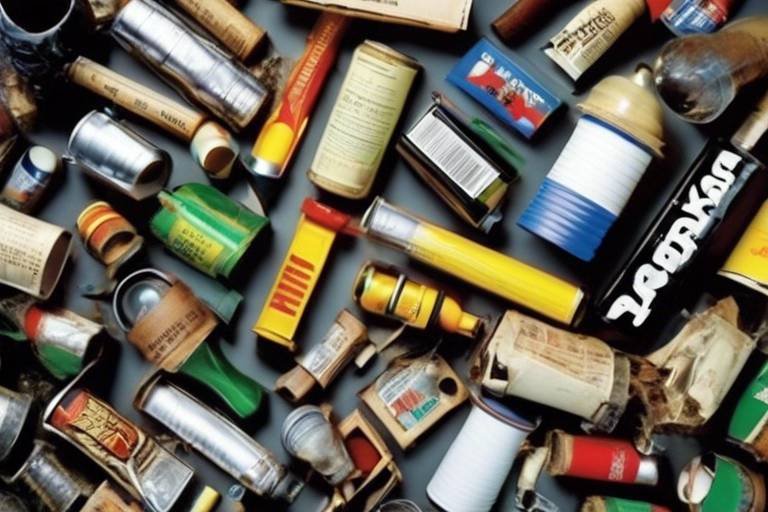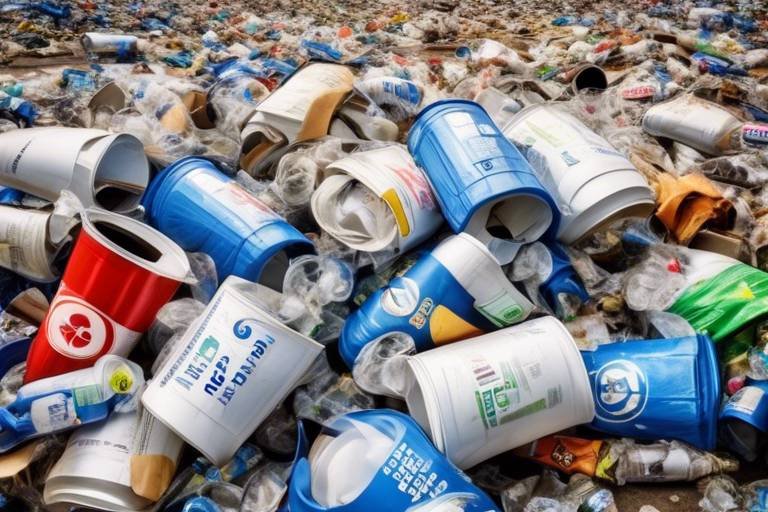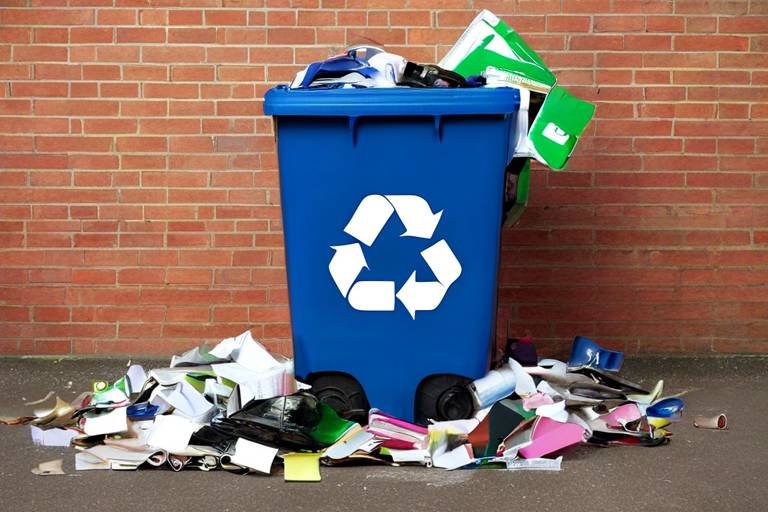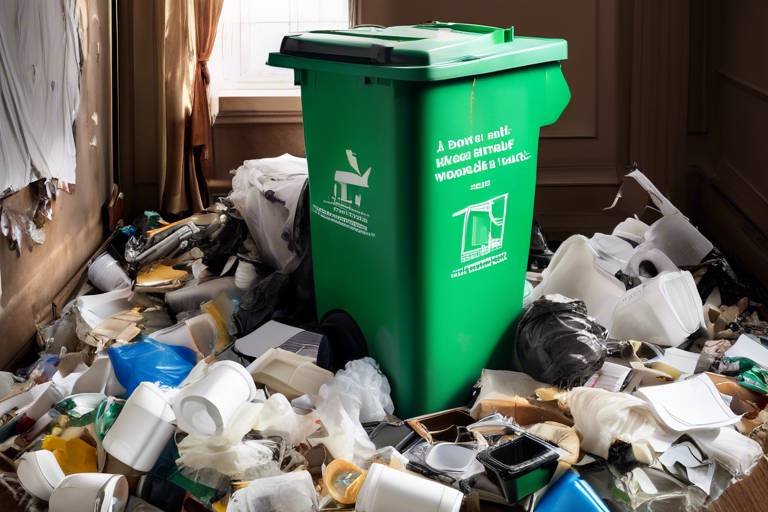How Can Festival Organizers Manage Waste More Effectively?
When it comes to festivals, the excitement is palpable! From the vibrant music to the delicious food, everything seems perfect. But behind the scenes, there's a significant challenge that festival organizers face: waste management. With thousands of attendees, the amount of waste generated can be overwhelming. So, how can festival organizers manage waste more effectively and ensure a cleaner, greener environment? It all starts with strategic planning and a commitment to sustainability.
First and foremost, understanding the waste hierarchy is essential. This framework prioritizes waste prevention, followed by reuse, recycling, and finally, disposal. By focusing on the top levels of this hierarchy, festival organizers can significantly reduce the amount of waste that ends up in landfills. This means not only thinking about what happens after the event but also considering how to minimize waste before it even occurs.
One of the most effective strategies is to implement recycling stations throughout the festival grounds. Imagine walking through the festival, and instead of seeing trash cans overflowing with rubbish, you find clearly marked recycling bins that encourage attendees to dispose of their waste responsibly. This visual cue can make a huge difference. But it’s not just about placing bins; it’s also about choosing the right types of bins for different materials. For example, having separate bins for plastics, metals, and paper can streamline the recycling process and ensure that more materials are diverted from landfills.
Moreover, educating attendees about proper recycling practices is crucial. Think of it as a friendly reminder in the form of creative signage or engaging workshops. Organizers could even consider using social media to spread the word before the event. This way, attendees arrive informed and ready to participate in sustainability efforts. The more people know, the more likely they are to get involved!
Another significant contributor to festival waste is organic materials, such as food scraps. Implementing composting stations is a fantastic way to manage this waste. Composting not only reduces the volume of waste but also transforms it into nutrient-rich soil that can benefit local gardens and parks. Setting up these stations requires careful planning; organizers need to ensure that attendees understand what can and cannot be composted. Clear signage and staff assistance can help guide festival-goers in making the right choices.
Furthermore, collaborating with local composting facilities can enhance these efforts. By partnering with organizations that specialize in composting, festival organizers can ensure that organic materials are processed correctly and efficiently. This partnership not only simplifies the composting process but also strengthens community ties and promotes local businesses.
Reducing single-use plastics is another critical area where festival organizers can make a significant impact. The rise of disposable plastics has created a massive environmental challenge, and festivals are often at the forefront of this issue. By encouraging the use of reusable alternatives—like water bottles, utensils, and plates—organizers can help cut down on plastic waste. Additionally, implementing bans on specific plastic items, such as straws or plastic bags, can further promote sustainability and encourage attendees to think twice about their choices.
Engaging vendors in these waste management efforts is also vital. Vendors are responsible for a large portion of the waste generated at festivals, so involving them in sustainability initiatives can lead to significant improvements. Organizers can provide guidelines and incentives for vendors to adopt eco-friendly practices, such as using biodegradable packaging or minimizing food waste. When vendors are on board, the entire festival can operate more sustainably.
Finally, measuring the success of waste management strategies is essential for continuous improvement. Organizers should track waste generation, recycling rates, and overall sustainability outcomes. By analyzing this data, they can identify areas for improvement and make informed decisions for future events. This not only helps in refining waste management practices but also demonstrates a commitment to sustainability that can resonate with attendees.
- What is the waste hierarchy? The waste hierarchy is a framework that prioritizes waste management practices, emphasizing prevention, reuse, recycling, and disposal in that order.
- How can I encourage recycling at my festival? Set up clearly marked recycling stations and educate attendees about proper recycling practices through signage and social media.
- What are the benefits of composting at festivals? Composting reduces organic waste, creates nutrient-rich soil, and promotes sustainability within the community.
- How can vendors contribute to waste management? Vendors can adopt eco-friendly practices by using biodegradable packaging and minimizing food waste, and they can be incentivized to participate in sustainability initiatives.

Understanding the Waste Hierarchy
The waste hierarchy is a fundamental concept that serves as a guiding principle for effective waste management. It prioritizes actions that minimize waste generation and promotes sustainable practices. Essentially, the hierarchy is structured in a pyramid format, where the most desirable actions are at the top and the least desirable ones are at the bottom. This framework helps festival organizers make informed decisions about waste reduction practices, ultimately leading to a cleaner and more sustainable environment.
At the top of the hierarchy is waste prevention. This involves strategies that aim to reduce the amount of waste produced in the first place. For festival organizers, this could mean planning events that utilize fewer materials or opting for digital tickets instead of paper ones. Next comes reuse, which encourages the use of items multiple times before they are discarded. For instance, providing reusable cups or encouraging attendees to bring their own containers can significantly reduce waste.
Following reuse, we have recycling. This is where materials are processed and transformed into new products, thereby diverting waste from landfills. Implementing effective recycling systems at festivals is crucial, as it helps recover valuable resources and reduces the environmental impact of the event. Finally, at the bottom of the hierarchy is disposal, which should be the last resort. This includes landfilling and incineration, methods that should be minimized as they contribute to environmental degradation.
By understanding and applying the waste hierarchy, festival organizers can create a roadmap for their sustainability initiatives. Here are some key points to remember:
- Prevention is better than cure: Focus on reducing waste at the source.
- Reuse whenever possible: Encourage practices that allow items to be used multiple times.
- Recycling is essential: Set up systems to ensure materials are properly recycled.
- Disposal should be minimized: Aim to reduce the amount of waste sent to landfills.
In conclusion, the waste hierarchy not only provides a clear framework for festival organizers but also encourages a shift in mindset towards sustainability. By prioritizing waste prevention, reuse, and recycling, festivals can significantly reduce their environmental footprint and promote a culture of sustainability among attendees.

Implementing Recycling Stations
When it comes to managing waste at festivals, one of the most effective strategies is the implementation of recycling stations. These stations serve as designated areas where attendees can dispose of their recyclable materials, making it easier for them to participate in sustainability efforts. By strategically placing these stations throughout the festival venue, organizers can significantly reduce the amount of waste that ends up in landfills. But how do you ensure that these recycling stations are effective?
First and foremost, visibility is key. Recycling stations should be prominently displayed and easily accessible. Consider placing them near food vendors, seating areas, and high-traffic zones to maximize their use. Additionally, each station should be clearly marked with signage that indicates what materials can be recycled. Using colorful graphics and simple language can help attendees quickly understand how to sort their waste correctly.
Another important aspect is the type of bins used at these recycling stations. It’s essential to choose bins that are not only visually appealing but also functional. For instance, using different colored bins for various materials—such as paper, plastics, and metals—can help guide festival-goers in making the right choices. A well-organized recycling station might look something like this:
| Bin Color | Material Type | Example Items |
|---|---|---|
| Blue | Paper | Napkins, cardboard, brochures |
| Green | Plastics | Bottles, containers, cups |
| Yellow | Metals | Aluminum cans, tin cans |
To further enhance the effectiveness of recycling stations, festival organizers should consider educational initiatives. Before and during the event, providing information about what can be recycled and the importance of recycling can boost participation rates. For example, organizers could distribute flyers, use social media campaigns, or even have volunteers stationed near recycling stations to assist attendees. This kind of engagement not only informs but also creates a sense of community responsibility.
Lastly, it's crucial to evaluate the success of your recycling stations. By tracking the amount of material collected and assessing contamination rates, organizers can identify areas for improvement. This data can inform future events, making them even more sustainable. Remember, the goal is not just to set up recycling stations but to create a culture of recycling that resonates with festival-goers long after the event ends.
- What materials can be recycled at the festival? Most festivals will accept paper, plastics, and metals, but it's important to check local recycling guidelines.
- How can we encourage attendees to use recycling stations? Use clear signage, engage volunteers, and provide educational materials to inform attendees about recycling practices.
- What should we do if a recycling bin is contaminated? Regularly monitor the bins and have a plan in place for cleaning out contaminated materials to ensure the integrity of the recycling process.

Choosing the Right Recycling Bins
When it comes to managing waste at festivals, is a game-changer. Imagine a bustling festival atmosphere filled with laughter, music, and delicious food. Now, picture that same scene littered with trash because attendees couldn't find the right place to dispose of their waste. It’s crucial for festival organizers to select bins that not only look appealing but also effectively serve their purpose. The goal is to make recycling as easy and intuitive as possible for everyone involved.
First, it’s important to consider the different types of materials that will be generated during the event. Festivals typically produce a variety of waste, including plastics, metals, and paper products. Therefore, having a diverse selection of recycling bins is essential. For instance, you might want to set up separate bins for:
- Plastic bottles
- Aluminum cans
- Cardboard and paper
Each bin should be clearly labeled with both text and visuals to help attendees quickly identify where to dispose of their waste. Think of it like a treasure hunt—if the clues are clear, the participants will find what they’re looking for! Using bright colors and universally recognized recycling symbols can make a significant difference in guiding festival-goers.
Another critical factor to consider is the size and accessibility of the bins. Large crowds mean a higher volume of waste, so it’s wise to opt for bins that can hold a substantial amount without overflowing. Additionally, placing bins at strategic locations—such as near food stalls, seating areas, and entrances—ensures that they’re easily accessible. No one wants to walk a mile just to find a place to toss their empty drink can!
Moreover, it’s not just about having the right bins; it’s also about the design and aesthetics. Recycling bins that are visually appealing can encourage more people to use them. Consider incorporating festival branding or fun designs that resonate with the event's theme. This approach not only promotes recycling but also enhances the overall festival experience.
Finally, regular maintenance of the recycling stations is vital. Assign volunteers or staff to monitor the bins throughout the event. This way, they can empty full bins and replace them as needed, ensuring that the stations remain functional and appealing. After all, a clean and well-organized recycling area reflects the festival's commitment to sustainability.
In summary, choosing the right recycling bins goes beyond just picking a few containers. It involves a strategic approach that considers the types of waste, visibility, accessibility, and aesthetics. By creating a user-friendly recycling environment, festival organizers can significantly boost recycling rates, making the event not only enjoyable but also environmentally responsible.
- What types of materials can be recycled at festivals? Most festivals can recycle plastics, metals, and paper products. It's essential to provide separate bins for each type to enhance recycling efforts.
- How can I ensure that festival-goers use the recycling bins correctly? Clear labeling with text and symbols, along with strategic placement of bins, can guide attendees in proper waste disposal.
- Are there any specific bin designs that work best for festivals? Yes, visually appealing and themed bins can encourage usage. Consider incorporating festival branding for a cohesive look.
- How often should recycling bins be emptied during the event? Regular monitoring is crucial. Assign staff or volunteers to check bins frequently, especially in high-traffic areas.

Educating Attendees on Recycling
When it comes to festivals, the excitement is palpable, but so is the potential for waste. One of the most effective ways to tackle this issue is by . Imagine walking through a lively festival, music blaring, and the smell of delicious food wafting through the air. Now, picture the trash bins overflowing with plastic cups, food wrappers, and other waste. It’s a sight that can easily be avoided with a little foresight and education.
First off, let’s talk about the power of visual communication. People are often more inclined to follow instructions when they are presented visually. Setting up eye-catching signs that illustrate what can and cannot be recycled can make a world of difference. For instance, a simple infographic showing the recycling symbols alongside images of acceptable items can help attendees quickly grasp what to do. These signs should be placed not only near recycling stations but also around high-traffic areas to maximize visibility.
But it doesn’t stop there! Engaging the audience through interactive workshops or demonstrations can create a buzz and foster a sense of community. Imagine a booth where attendees can learn how to properly sort their waste through a fun game or challenge. This hands-on approach not only educates but also makes recycling feel like a shared responsibility, turning a mundane task into an enjoyable experience.
Another key aspect is utilizing social media. In today’s digital age, platforms like Instagram and Twitter can be powerful tools for spreading awareness. Organizers can create catchy hashtags that encourage attendees to share their recycling efforts, sparking a friendly competition. For example, using a hashtag like #RecycleFest2023 can motivate festival-goers to post pictures of themselves using recycling stations, which can lead to greater participation.
Moreover, consider offering incentives for recycling. Small rewards, such as discount coupons for food vendors or exclusive merchandise, can encourage attendees to think twice before tossing their waste in the wrong bin. This not only boosts recycling rates but also enhances the overall festival experience, making attendees feel like they are part of something bigger.
To wrap it all up, educating attendees on recycling is not just about providing information; it’s about creating a culture of sustainability. By implementing visual aids, interactive experiences, social media engagement, and incentives, festival organizers can turn recycling into a fun and integral part of the event. After all, who wouldn’t want to be a part of a movement that not only enhances their festival experience but also contributes to a cleaner planet?
- Why is recycling important at festivals? Recycling helps reduce waste, conserves resources, and minimizes the environmental impact of events.
- How can I identify recyclable materials? Look for the recycling symbol on items, and check for signs at recycling stations that indicate what can be recycled.
- What if I’m unsure about an item’s recyclability? When in doubt, ask a volunteer or staff member for guidance, or refer to the informational signage provided at the festival.
- Are there any penalties for not recycling? While there may not be formal penalties, not recycling can contribute to environmental harm and negate the festival's sustainability efforts.

Composting Organic Waste
Composting is not just a trend; it's a transformative practice that can significantly reduce the amount of organic waste generated at festivals. Imagine turning food scraps, napkins, and other biodegradable materials into nutrient-rich soil instead of letting them rot in a landfill. By implementing composting systems, festival organizers can not only minimize waste but also contribute to a healthier environment. This process is like giving back to the earth, helping it flourish while simultaneously reducing the carbon footprint of the event.
One of the most compelling reasons to compost is the sheer volume of organic waste that festivals produce. Consider this: a festival with thousands of attendees can generate tons of organic waste in just a few days. By composting, organizers can divert a significant percentage of this waste from landfills, where it would otherwise release harmful greenhouse gases as it decomposes. Instead, composting transforms these materials into a valuable resource that can enrich soil, support local agriculture, and promote biodiversity.
Implementing composting stations at festivals requires thoughtful planning and execution. Organizers should start by identifying the types of organic waste expected, such as food scraps, paper products, and yard waste. Once this is established, they can set up designated composting areas that are easily accessible to both vendors and attendees. It's essential to clearly mark these stations with informative signage that explains what can and cannot be composted. This clarity will help reduce contamination and ensure that the composting process runs smoothly.
In addition to setting up composting stations, festival organizers can enhance their efforts by collaborating with local composting facilities. These partnerships can provide a seamless solution for managing organic waste. By working with experts in the field, organizers can ensure that the composting process is handled correctly and efficiently. This collaboration can also help in educating the community about the benefits of composting and how it contributes to sustainability.
Moreover, engaging attendees in the composting process can turn a simple waste management strategy into an interactive experience. For instance, organizers can host workshops or demonstrations on composting techniques, encouraging festival-goers to get involved. This not only raises awareness but also fosters a sense of community and responsibility towards the environment. Imagine the impact of having attendees leave the festival not just entertained but also educated about sustainable practices!
Incorporating composting into festival waste management strategies is not merely about reducing waste; it's about creating a culture of sustainability. By prioritizing composting, festival organizers can pave the way for a greener future, inspiring others to follow suit. It's a win-win situation: the environment benefits, and attendees leave with a sense of accomplishment, knowing they contributed to a cleaner planet.
- What types of materials can be composted at festivals? Generally, food scraps, paper products, and yard waste are compostable. However, it’s essential to avoid items like plastic, metals, and certain food waste like dairy and meat.
- How can we prevent contamination in composting stations? Clear signage indicating what can and cannot be composted, along with staff or volunteers to supervise the stations, can significantly reduce contamination.
- Is it expensive to set up composting stations? While there may be initial costs involved, the long-term benefits of reducing waste disposal fees and contributing to sustainability often outweigh these costs.
- Can composting really make a difference? Absolutely! Composting can divert a significant amount of organic waste from landfills, reduce greenhouse gas emissions, and create valuable compost for local soil enrichment.

Setting Up Composting Stations
Setting up composting stations at festivals is not just a trend; it's a necessity for promoting sustainability and reducing waste. Imagine a vibrant festival where the air is filled with laughter, music, and the delightful aroma of food, all while knowing that every bit of organic waste is being transformed into nutrient-rich compost. Sounds appealing, right? To achieve this, festival organizers need to consider several key factors that will ensure the success of composting efforts.
First and foremost, location is crucial. Composting stations should be easily accessible to attendees, ideally placed near food vendors and dining areas where organic waste is most likely to be generated. Think of it as setting up a lemonade stand at a hot summer fair; you want to be where the action is! Additionally, clear signage is essential. Use bold colors and simple graphics to indicate what can and cannot be composted. This visual aid will help guide attendees in making the right choices when disposing of their waste.
Next, consider the type of composting system you want to implement. There are various options available, such as traditional compost bins, worm bins, or even portable composting toilets for organic waste. Each option has its pros and cons, so it's important to choose one that fits the scale and needs of your festival. For instance, if your festival is large and generates a significant amount of organic waste, a traditional compost bin system may be the most effective. On the other hand, smaller events might benefit from worm bins, which can handle food scraps efficiently while being compact.
Once the composting stations are set up, it’s vital to train staff and volunteers on how to manage them. This includes educating them on what materials are compostable, how to monitor the composting process, and how to handle any issues that may arise. Having knowledgeable individuals at each station can significantly improve the experience for festival-goers, as they can provide guidance and answer questions. After all, people are more likely to participate when they feel supported and informed.
Lastly, don't forget to promote your composting efforts through social media, festival programs, and announcements during the event. By highlighting your commitment to sustainability, you’re not only encouraging attendees to participate but also setting a positive example for other festivals to follow. Imagine the satisfaction of seeing a vibrant compost pile grow throughout the event, knowing that you played a part in reducing waste and promoting a greener future.
In summary, setting up composting stations at festivals requires careful planning, strategic placement, and effective communication. By taking these steps, festival organizers can create a successful composting program that not only minimizes waste but also enhances the overall festival experience.
Q: What can be composted at festivals?
A: Most organic materials can be composted, including fruit and vegetable scraps, coffee grounds, and paper products like napkins. However, items like meat, dairy, and oily foods should be avoided.
Q: How do I know if my compost is working?
A: A good compost pile will heat up, break down organic matter, and eventually turn into a dark, crumbly substance. Regular turning and monitoring moisture levels can help ensure success.
Q: Can I set up a composting station at any type of festival?
A: Yes! Whether it's a music festival, food festival, or community event, composting stations can be adapted to fit various types of gatherings.

Collaborating with Local Composting Facilities
When it comes to managing organic waste at festivals, can be a game-changer. By partnering with these facilities, festival organizers can ensure that the organic materials generated during the event are processed efficiently and sustainably. This not only helps in reducing waste sent to landfills but also supports local businesses that are dedicated to environmental stewardship.
One of the first steps in establishing this collaboration is to identify local composting facilities that are equipped to handle the volume and type of organic waste your festival will generate. This might include food scraps, plant materials, and other biodegradable items. It's essential to engage with these facilities early in the planning process to discuss their capabilities and requirements. For instance, some facilities may have specific guidelines on what can be composted, while others might offer different services, such as collection or on-site composting solutions.
In addition to logistical considerations, building a strong relationship with local composting facilities can lead to mutual benefits. For example, organizers can promote these facilities as partners in sustainability, highlighting their commitment to eco-friendly practices. This can be showcased in marketing materials, event signage, and social media campaigns, creating a positive image for both the festival and the composting facility. Furthermore, some facilities may be willing to provide educational resources for festival-goers, teaching them about the composting process and the importance of reducing food waste.
To facilitate a successful partnership, it's crucial to establish clear communication channels. Regular meetings can help align goals and address any challenges that arise. Additionally, festival organizers should be prepared to share data on the amount of organic waste generated, which can help the composting facility plan for capacity and resources. In return, the facility can provide feedback on the quality of the compost produced, which can further enhance the festival's sustainability efforts.
Ultimately, collaborating with local composting facilities not only enhances waste management practices but also fosters a sense of community engagement. By supporting local businesses, festival organizers can create a ripple effect that encourages attendees to adopt more sustainable practices in their daily lives. This partnership is a win-win situation, paving the way for a cleaner environment and a more responsible approach to waste management.
- What types of organic waste can be composted? Most food scraps, yard waste, and some biodegradable materials can be composted. It's best to check with your local facility for specific guidelines.
- How can I find local composting facilities? You can search online or contact local environmental organizations for recommendations on nearby composting facilities.
- What are the benefits of composting at festivals? Composting reduces landfill waste, enriches soil, and promotes sustainability, which can enhance the festival's image.
- Can I compost at the festival site? Yes, some festivals choose to implement on-site composting solutions, but this requires additional planning and resources.

Reducing Single-Use Plastics
In an era where environmental consciousness is at an all-time high, at festivals has become more than just a trend; it's a necessity. These plastics, often used for mere moments, can take hundreds of years to decompose, causing significant harm to our planet. So, how can festival organizers take a stand against this plastic plague? One effective strategy is to encourage the use of reusable alternatives and to implement bans on specific plastic items that are known to contribute to waste. Imagine a festival where attendees sip from their stylish stainless-steel water bottles instead of single-use plastic cups. Not only does it look good, but it also sends a powerful message about sustainability!
One of the first steps in this journey is to educate festival-goers about the impact of single-use plastics. This can be achieved through engaging campaigns that highlight the benefits of switching to reusable items. For instance, organizers can set up booths that provide information about the environmental impact of plastic waste, while also offering alternatives like biodegradable cups or even compostable utensils. By making this information readily accessible, attendees are more likely to make informed choices that align with sustainable practices.
Moreover, collaborating with vendors is crucial in this effort. Festival organizers can set clear guidelines for vendors regarding the types of materials they are allowed to use. This may include banning plastic straws, cutlery, and plates, while encouraging the use of eco-friendly options such as bamboo utensils or plant-based containers. When vendors are on board, the impact is multiplied, creating a ripple effect throughout the festival. Imagine walking through a festival where the vibrant colors of reusable containers and bags replace the dullness of plastic waste – it’s not just a dream but a tangible reality!
Another effective approach is to offer incentives for attendees who bring their own reusable items. For example, festival organizers can provide discounts on drinks or food for those who come equipped with their own containers. This not only encourages behavior change but also fosters a sense of community among festival-goers. After all, who doesn’t love a good deal? It’s a win-win situation!
Additionally, incorporating refill stations for water and other beverages can significantly cut down on plastic waste. By providing easily accessible refill stations, attendees can fill up their reusable bottles throughout the event, minimizing the need for single-use plastic bottles. Think of it as creating an oasis of sustainability amidst the excitement of the festival. This simple yet effective measure can lead to a substantial reduction in plastic consumption.
Lastly, it’s important to measure the impact of these initiatives. By tracking the amount of single-use plastics used before and after implementing these strategies, organizers can quantify their success and identify areas for improvement. This data not only helps in refining future festivals but also serves as a powerful tool to encourage other events to follow suit. The more we share our successes, the more we inspire others to join the movement towards a plastic-free future.
In conclusion, reducing single-use plastics at festivals is not just an environmental initiative; it’s a cultural shift towards sustainability. By educating attendees, collaborating with vendors, providing incentives, and tracking progress, festival organizers can create an unforgettable experience that prioritizes our planet. So, the next time you’re at a festival, look around and appreciate the effort that goes into making it a greener event. Together, we can turn the tide on plastic waste!
- What are single-use plastics? Single-use plastics are items designed to be used once and then discarded, such as plastic bags, straws, and water bottles.
- How can I reduce my plastic use at festivals? Bring your own reusable containers, opt for vendors that use eco-friendly materials, and utilize refill stations for drinks.
- Why is reducing plastic waste important? Reducing plastic waste helps to protect the environment, wildlife, and human health by minimizing pollution and conserving resources.

Engaging Vendors in Waste Management
When it comes to managing waste at festivals, engaging vendors is not just a good idea; it's a necessity. Vendors are often the frontline of waste generation, providing food, beverages, and merchandise that can contribute significantly to the overall waste footprint of an event. So, how can festival organizers ensure that vendors are on board with waste management practices? The answer lies in collaboration, education, and incentivization.
First and foremost, it's essential to create a collaborative environment where vendors feel like partners in sustainability efforts rather than just service providers. This can be achieved by hosting pre-festival meetings to discuss waste management goals and expectations. During these meetings, organizers can share their vision for a cleaner festival and outline how vendors can contribute. For instance, they can encourage vendors to adopt eco-friendly packaging, such as biodegradable containers or reusable dishes. By fostering a sense of community and shared responsibility, vendors are more likely to take ownership of their waste practices.
Moreover, providing educational resources can significantly enhance vendors' understanding of waste management. This could include workshops on composting, recycling, and reducing single-use plastics. Organizers can also supply informational materials that outline best practices for waste disposal and the benefits of sustainable practices. For example, a simple flyer could highlight the importance of recycling and the positive impact it has on the environment. When vendors are informed about the environmental implications of their choices, they are more likely to make sustainable decisions.
Incentives can also play a crucial role in engaging vendors. Offering discounts on booth fees for those who demonstrate sustainable practices can motivate vendors to participate actively in waste management efforts. Additionally, organizers can create a competition among vendors for the title of the "Most Sustainable Vendor," rewarding the winner with prizes or recognition. This not only encourages vendors to adopt better practices but also creates a friendly, competitive atmosphere that can enhance the overall festival experience.
To track vendor participation and success in waste management, organizers can implement a monitoring system. This could involve regular check-ins during the festival to assess waste generation and disposal practices. Feedback from vendors can also provide valuable insights into the challenges they face in implementing sustainable practices. By maintaining open lines of communication, organizers can make necessary adjustments and continuously improve waste management strategies.
Ultimately, engaging vendors in waste management is about building a culture of sustainability that permeates the entire festival. By working together, sharing knowledge, and incentivizing eco-friendly practices, festival organizers can create a more sustainable event that benefits not only the environment but also the vendors and attendees. It's a win-win scenario where everyone plays a part in reducing waste and promoting a cleaner, greener future.
- Why is it important to engage vendors in waste management? Engaging vendors is crucial because they are significant contributors to waste generation at festivals. Their participation can greatly enhance the effectiveness of waste management efforts.
- What are some effective ways to educate vendors about sustainability? Organizers can hold workshops, provide informational materials, and share success stories to educate vendors about sustainable practices.
- How can I incentivize vendors to adopt eco-friendly practices? Offering discounts on booth fees or creating competitions for the most sustainable vendor can motivate them to implement better waste management strategies.
- What should I do if a vendor is not compliant with waste management practices? Open communication is key. Discuss their challenges, provide additional resources or training, and set clear expectations for compliance.

Measuring Waste Management Success
When it comes to festivals, measuring waste management success is not just a good idea; it's essential! How do you know if your efforts to minimize waste are actually making a difference? It's like trying to navigate a ship without a compass—you might be moving, but are you heading in the right direction? To truly gauge the effectiveness of your waste management strategies, you need to establish clear metrics and methods for evaluation.
One of the most straightforward ways to measure success is by tracking the amount of waste generated versus the amount that is recycled or composted. Setting up a system to monitor these figures can reveal a lot about your festival’s sustainability performance. For example, if you find that only 20% of your waste is being recycled, it might be time to revisit your recycling initiatives. Here’s a simple table that outlines some key metrics to consider:
| Metric | Description | How to Measure |
|---|---|---|
| Total Waste Generated | Overall waste produced during the festival | Weigh all waste collected at the end of the event |
| Recycling Rate | Percentage of waste that is recycled | (Recycled Waste / Total Waste) x 100 |
| Composting Rate | Percentage of organic waste that is composted | (Composted Waste / Total Organic Waste) x 100 |
| Single-Use Plastic Reduction | Decrease in single-use plastics compared to previous events | Compare plastic waste weight from past festivals |
In addition to quantitative metrics, qualitative feedback is equally important. Gathering insights from attendees, vendors, and staff can provide invaluable information about the effectiveness of your waste management strategies. Consider conducting surveys or interviews post-event to understand their perspectives. Questions could include:
- How aware were you of recycling stations?
- Did you feel that waste disposal options were adequate?
- What suggestions do you have for improving waste management?
Another effective method for measuring success is through benchmarking. Compare your festival’s waste management performance with similar events. This not only helps you understand where you stand but also provides an opportunity to learn from others who are successfully implementing sustainable practices. It’s like looking at the top athletes in a sport; you can see what techniques they use and adapt them for your own success.
Finally, don’t forget to celebrate your achievements! Sharing your waste management success stories with attendees and stakeholders can foster a culture of sustainability. Use social media, newsletters, or post-event reports to highlight how much waste was diverted from landfills, the positive impact on the environment, and the collective effort of everyone involved. When people see the tangible results of their actions, they’re more likely to participate in future sustainability initiatives.
In conclusion, measuring waste management success is a multifaceted approach that combines quantitative data, qualitative feedback, and benchmarking with other events. By keeping track of your metrics and sharing your successes, you not only improve your festival’s sustainability but also inspire others to follow suit. So, what are you waiting for? Start measuring, start improving, and let’s make our festivals cleaner and greener!
Q1: Why is measuring waste management success important?
A1: It helps organizers understand the effectiveness of their waste reduction strategies and identify areas for improvement.
Q2: What metrics should I focus on?
A2: Key metrics include total waste generated, recycling rates, composting rates, and reductions in single-use plastics.
Q3: How can I gather feedback from attendees?
A3: You can conduct surveys or interviews after the event to gather insights on their experiences with waste management.
Q4: How can I benchmark my festival against others?
A4: Research similar events and compare waste management metrics and practices to identify best practices and areas for improvement.
Frequently Asked Questions
- What is the waste hierarchy and why is it important for festivals?
The waste hierarchy is a framework that prioritizes waste management strategies in the following order: prevention, reuse, recycling, and disposal. For festival organizers, understanding this hierarchy is crucial as it guides them in making informed decisions that minimize waste, promote sustainability, and enhance the overall environmental impact of their events. By focusing on prevention and reuse first, festivals can significantly reduce the amount of waste generated.
- How can I effectively set up recycling stations at my festival?
To set up effective recycling stations, ensure they are clearly marked and strategically placed throughout the festival venue. Use different colored bins for various types of recyclables, and provide clear signage that explains what can and cannot be recycled. Additionally, consider having volunteers or staff available to assist attendees in properly disposing of their waste, which can significantly improve recycling rates.
- What types of recycling bins should I choose for my event?
Selecting the right recycling bins is essential for maximizing recycling rates. Consider using bins specifically designed for recycling, composting, and landfill waste. Color-coded bins can help attendees quickly identify where to dispose of their waste. For example, blue bins for recyclables, green bins for compost, and black bins for trash. It's also helpful to choose bins that are durable and weather-resistant, especially for outdoor festivals.
- How can I educate festival-goers about recycling practices?
Educating attendees about recycling can be done in several creative ways. Prior to the event, use social media, newsletters, and your festival website to share information about recycling practices. During the festival, consider using engaging signage, interactive displays, or even short announcements to remind attendees to recycle. You might also host workshops or demonstrations on proper recycling techniques to encourage participation.
- What are the benefits of composting organic waste at festivals?
Composting organic waste not only reduces the amount of waste sent to landfills but also creates nutrient-rich soil that can be used to enrich local gardens and landscapes. By implementing composting stations, festival organizers can divert a significant portion of organic waste, such as food scraps and biodegradable materials, from the waste stream. This practice promotes sustainability and can enhance the festival's eco-friendly image.
- How can I collaborate with local composting facilities?
Collaborating with local composting facilities can greatly enhance your festival's waste management efforts. Start by researching composting facilities in your area and reach out to discuss potential partnerships. They may provide guidance on setting up composting stations, offer collection services for organic waste, and even help with education efforts. Building this relationship can ensure that organic materials are processed properly and sustainably.
- What strategies can I implement to reduce single-use plastics at my festival?
To reduce single-use plastics, consider encouraging attendees to bring their own reusable containers and water bottles. You can also provide water refill stations throughout the venue. Additionally, collaborate with vendors to offer eco-friendly alternatives to plastic products, such as compostable plates and utensils. Implementing a ban on specific plastic items, like straws and plastic bags, can also significantly reduce plastic waste during the event.
- How can I engage vendors in sustainability efforts?
Engaging vendors in sustainability efforts is crucial for effective waste management at festivals. Start by communicating your waste reduction goals and expectations clearly. Encourage vendors to adopt eco-friendly practices, such as using biodegradable packaging and minimizing food waste. You can also incentivize participation by offering discounts on vendor fees for those who demonstrate sustainable practices, creating a win-win situation for all involved.
- How can I measure the success of my waste management strategies?
Measuring the success of your waste management strategies involves tracking key metrics such as waste generation, recycling rates, and composting amounts. Conduct waste audits before and after the event to gather data on the types and quantities of waste produced. Surveys and feedback from attendees can also provide insights into their experiences and participation in sustainability efforts, helping you identify areas for improvement for future festivals.



















